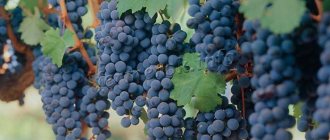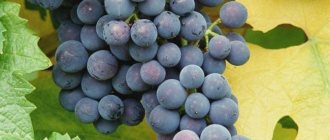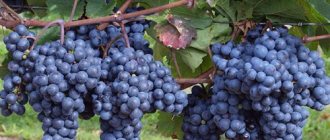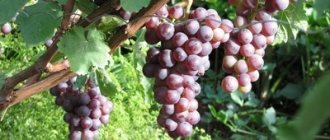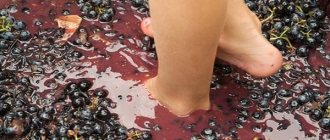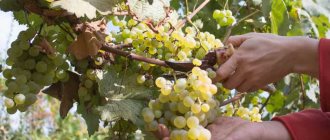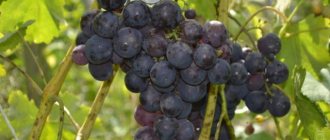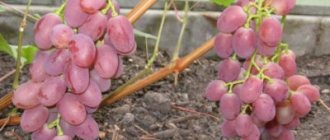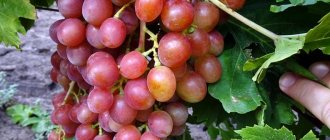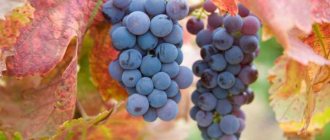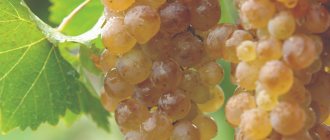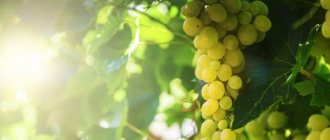Fruits and berries » Grapes
0
1021
Article rating
Kira Stoletova
One of the interesting varieties is the Northern Shoulder grape. It contains a huge amount of vitamins and microelements, especially necessary for residents of regions with harsh climates.
Growing grapes Northern shoulder
Characteristics and description of the variety
This is a hybrid of European and Amur grapes, medium late, in the Rostov region the fruits ripen by mid-September. The bushes grow to medium and above average height. The flowers of the vine are bisexual. The brushes are conical or cylindrical-conical, large, medium in density, weighing on average 370 g, the largest - 700 g.
The grapes are medium in size, round in shape, the color of the skin is dark blue, almost black. Weight, on average, 2.2 g. The pulp of the grapes is juicy, the skin is medium-dense, and is easily separated from the pulp. The taste is considered harmonious; a lot of light-colored juice can be obtained from the pulp - up to 85%. The sugar content of the Northern Shoulder grape is 22-24 g/100 cm3, acidity is 8-9 g/dm3.
The variety has average resistance to fungal diseases, high winter hardiness, grapes can be grown without covering, with the exception of the regions of the Urals and Siberia. The yield level is high, the grapes are versatile, the berries can be used for food and for making table wines.
Reviews
Evgeniya
I live in a region with a humid climate, and oddly enough, the Northern Shoulder has never been sick for 10 years, although many complain about its weak immunity. Taking into account my growing conditions, I concluded that there will be no illnesses if new table varieties are not planted nearby and the bushes are properly cared for. I don’t do pruning “according to the rules”; every year I shape the bush the way I want, the harvests are always excellent. During the summer, I remove all fallen leaves and berries, and add a layer of mulch for the winter.
Victoria
I’ve been growing shoulder grass for 8 years, there is also an old bush, I don’t know how old it is, I got it from the old owners of the dacha. I noticed an interesting detail - in one year there are a lot of clusters, they are medium in size, loose, but the next season the clusters are dense and large. This happens from year to year, while the yield remains at the same level. The taste is pleasant, the berries are very sweet, the juice yield is good - perfect for wine! I recommend planting, but be prepared for constant treatments against diseases.
Pros and cons of Northern shoulder grapes
Advantages of the variety:
- winter hardiness;
- disease resistance;
- dense clusters;
- juicy pulp;
- excellent taste;
- productivity;
- the ability to use berries for food and juice making.
Disadvantages: reduced yield and deterioration in taste if the bushes do not get enough water.
See also
Description and characteristics of Pinot Grigio grapes, pros and cons, cultivationRead
Characteristics
| Purpose of the variety | wine variety, sometimes used as a table variety |
| Bunch shape | Cylindrical or conical, upper blades well developed |
| Bunch weight | 350 g (can reach 1.5 kg) |
| Berries shape | slightly oval |
| Berry weight | Medium size (14-15 mm) |
| Berry color | dark blue, coated |
| Taste | sweet, juicy |
| Productivity | 10 kg/m (8-9 t/ha) |
| Pulp | unstructured, without a pronounced aroma, colorless juice. |
| Sugar content | 23% |
| Sheet | medium, round, slightly elongated, heavily pubescent below, streaked with bristles. |
| Flowers | predominantly female |
| Maturation | mid-season (135-140 days) |
| Frost resistance | up to -32 degrees Celsius |
| Disease resistance | average |
| Advantages | uncovered |
Due to its increased resistance to frost, Northern Pleschistik is currently grown in many regions of the Russian Federation. It can be found even in the Yaroslavl region. However, this variety is not very resistant to diseases, especially fungal ones, and is severely and often affected by mildew, after which careful treatment is required.
To obtain a large harvest, the soil for planting must be fertile, and the planting area must be provided with moisture.
Subtleties of growing a plant
The Northern Shoulder variety needs to be planted correctly, choose the right place for planting and during planting follow the recommendations on agricultural practices for the crop. Then the engraftment will be successful, the plant will not get sick, and will quickly continue to grow and develop.
Where and when to plant
The time for planting Northern shoulder grape seedlings occurs 2 times a season - in spring and autumn. On the site you need to choose a south or south-west side so that the vine is illuminated by the sun and protected from the wind.
The crop prefers neutral, sandy or loamy, light and fertile soil.
Before planting, you need to prepare a planting hole; its width and depth must be at least 0.5-0.7 m. A drainage layer must be placed down so that it drains excess water from the roots. You also need to prepare a fertile substrate, its composition: half of the excavated soil, sand, humus and ash. The whole mixture must be mixed well.
Landing rules
A distance of 1.5-2 m in a row and at least 2 m in row-spacings should be left between the seedlings of the Northern Shoulder. Each seedling is planted in a previously prepared hole. The planting process is simple: straighten the roots, place the grapes in the center, sprinkle with soil. Water and cover the surface with a layer of mulch.
Features of agricultural technology
The peculiarity of this grape is that the colder the climate in which it grows, the tastier and healthier the berries. To grow the Northern variety, you need to take into account some tricks and subtleties of agricultural technology.
Landing
To plant, wait until the ground warms up. It should thaw by at least half a meter. In the northern regions this occurs at the end of May or early June.
To wait for favorable weather, the shoulder blade is dropped into a container and left in a place where there are no drafts.
Uniform heating of the soil is achieved by digging a trench along the entire planting, on its southern side. The meltwater will recede faster, and the earth will quickly heat up to the desired temperature throughout its entire depth.
If it is impossible to dig a trench (there is not enough space or there is simply no way to drip in this place), the grapes should be planted in ridges up to 70 cm high, located in an easterly direction. This allows you to increase the temperature by 2°C, the intensity of bud growth and uniform light distribution. With this method of planting, rotting from excess moisture does not threaten the root system.
Fertilizer
The vine grows intensively and requires additional nutrients. With ridge planting, the intensity of their consumption increases significantly.
Soil enrichment is carried out several times per season. In the first ten days of May, 10-12 kg of rotted manure or other organic matter is added to each bush. This helps the growth and development of shoots and slows down the leaching of essential minerals due to rain. The fertilizer is laid out under the bushes and nothing is added in. This makes it possible to receive nutrition through the lower row of leaves, and then through the root system.
In the northern regions, fertilizers must be applied in proportion to the harvest obtained last year. This is the main feature of the fertilization procedure for this variety.
Related article: Bakhtiori – Uzbek wine grape variety
Further care of the bush
After planting, a period of plant care begins. The grapes need to be watered, fertilized, monitored, and pruned. After the end of the season, cover for the winter.
Watering and fertilizing
The young seedling is watered often at first, 1 or 2 times a week, until it takes root. 2 months after planting, you can reduce the frequency of watering to once a month. An adult bush should be watered only during drought; this is especially important, since with a lack of water, the number of grapes decreases.
Fertilizing is carried out starting next year after planting. At first, they fertilize only in the spring; after the start of fruiting, the bush is fertilized at least 3 times: before the leaves begin to bloom, after the fruits set, and when they reach the size of a pea. At the first feeding, nitrogen-containing fertilizers are applied, at the 2nd and 3rd – phosphorus-potassium fertilizers.
See also
Description and characteristics, advantages and disadvantages of the Galbena Nou grape variety and subtleties of cultivationRead
Pruning crop
In the fall or next year, in the spring you need to prune the shoots of the Northern shoulder grapes. Remove all old and fruit-bearing shoots, dry and damaged, or frozen in the spring. After flowering, leave no more than 2 inflorescences on each shoot so as not to overload the plant.
Winter period
Despite the fact that, according to its characteristics, the variety can withstand frost down to -30˚C, in the northern regions the grapes need to be covered. To do this, the shoots are removed from the trellis, tied together and laid on the ground.
Expert opinion
Zarechny Maxim Valerievich
Agronomist with 12 years of experience. Our best country expert.
Ask a Question
The top is covered with insulating material. In other, warmer regions, only the soil can be insulated.
Forum statistics
207036 Messages in 1634 Topics from 5593 Users. Last user: Amaya Last message: “Let's talk about the weather in Vash...” ( Today at 07:52:22 ) Latest messages on the forum.
Now on the forum
72 Guests, 13 Users
Users in the last 15 minutes: Evgeniy52, kvg, ElenkaF, Vasily 53, sergei, ALEX, Ser, Evgeniy 163, Elvira2017, Lyubov S., Erem, Ekaterina Polyanina, kosmos [Blocked] [Section Moderator] [Forum Moderator]
Maximum online today: 100 . All-time maximum online: 2758 (28 July 2021, 17:22:51)
Users who visited the forum in the last 24 hours
Total: 294
(Visible: 293, Hidden: 1) 1963, kvg, Evgeniy52, ElenkaF, Vasily 53, sergei, ALEX, Ser, Evgeniy 163, Elvira2017, Lyubov S., Erem, Polyanina Ekaterina, kosmos, Yura, GALINA ANOKHINA, DorontsovPeter, Zaycev AS , Alex65, 77volt, 64nikolay64, Vova Kapran, zsb, Polina77, spotlight, Mikhail Alekseevich, Svetla777, Quiet, Marshal, Nikolay S., therapist, Liza, Capricorn, lomakin1969, Alexander Vl., Andrey76, Slavka, Mikhail77, Tatyana B, Cherkessk, Eugene, Leonidych, vladimirM, yotmast, mers, Serg1707, SNovichek, hanter64, znakomij, Alexander K, Vardan, Sergey Fer, Anatoly Sivkov, Alexey V, Ilya 77, Andrey Gladilin, Tatyana A., Belgorodets, in Astrakhan, Oksana Kopp, sem_en, Vladimir 153, skier, Igor Viktorovich, slavalimon, Primorets, OlgaOs, SANYCH, 31rus, mystic69, Andrey Tsvetkov, Buba, igor222, Elena Z, vlad51, Kenig, Nikolay Rex, Sergey 1965, Vladimir Buturlakin, DSW, psv1960 , Dmitry 77, Vasily V., Vyacheslav03, Natalia Nikolaevna, Sergey Tashchiyan, Igor Sergeevich, alexsandr, Pioneer, nicson7, Elena Aleshchenko, Alexander-ask-34, Verona, Igor F., Taker, Henry, Yuri72, L.A. P., Gaivoronsky Yuri, Sergeevich, Sergey Chistokletov, Svetlana Streletskaya, Galinka, Alexey Deminov, Naumov Igor, Vyacheslav136, Gloomy, Katrin, AndSanych, Mikhno Alexander, Ded31, Filippov Oleg, Vladimir ++, Lydia58, ALEXANDER BRYANSKY, Vladimir-kanevskaya , DIL, Amber7394, Marina Protasova, TITOVA LYUBOV, Linx, alexander66, Natalya M, Mikhail Fesenko, Amaya, Alexander71, Boris 1952, tsv, Maximilian, 25nata35, nadia, Igor_K, Alexander Kolesnikov, Ivan Levin, Pitko, weather forecaster, eSAa, cecet71, atseton, Alexander Smirnov, Vladimir Kostochkin, Vladimir Berdnikov, Gocha, pioneer-2, LeXa_KoT, Sergey 61, Sergey Yuryev, alexss, Skif, Vladimir Kovba, dayton, Yuri Semyonov, N.A. Sokolov, Pavlentiy, Sa-shura , Volgogradka, Dmitry Anatolyevich, Grandfather Igor, Andrey Lis, Bublichenko Alexander M, Marina Krymskaya, stenlly2010, irahelm, Vyacheslav Vladimirovich, Vladimir Shilov, Aprel, Badaev Dmitry, gheo55, y_fed, rambo, Yagodka, Valentina Ivanovna, Kryn, oleg9f, DED 2 , Korotina Svetlana, Oleg Ivanovich delivered, Eduard., santra, L2k2m7n, Alexander48, Viknik, Andrey 31, m2d, Valery Rastorguev, soshnin yura, Amateur gardener, Galina, vasily1111, gardener, marlin64, Salex, Sergey Ko, Ramiz, victor_ , potap05, Yuri 36, VitalySD, Inna161, Vladimir Shcherbinin, Valerie, niy1, cfibr, Andrey68, kulol3, thanatos, Serzh1978, Realist, Artur53, max2008-01, LOZA, AlexanderD, Ded Young, Natasha, Zayac, ketch, Rita, alx-74, Iv Iv, Alexander150, Igor K, Vasily Viktorovich, VeraNiK, kdm57, Veniaminovich, Boris Sokolyansky, , vikbublik, neposny, Evgen, Victoria Aleksandrovna, Serezha 64, Wintel, Airbone, teri, Sergey Lomonosov, Khramov, serginio, Leonty Yarygin, Irina O., Nadezhda Grig, netolya, Saisan, Alexey Agryzkov, Vadi, Zinaida, Vadim, Alexander Taganrog, Sergey Sukhonos, Snezhinets, evgen_26, nau_63, Masha_gardener, Gennady163, krasnovlad1, Alexander Zinoviev, Roman Fedorovich, TIS, Alexey Sergeevich, Arnyusha, Zheka, Nurtas, kradievska, nick041, Valentina Medvedeva, Sergey43, Andrey S., Nikolay Lipunov, Mst, Vertuoz2, Vladimir VS, NatalyaMed, freesia, Kinna, Mikhail Michurinsk, alekcsan1, VALERY TAMB, Sasha57, MikhAf, Y_Azer , Andrey Beribesov, hunter1955, nut lover, Keys, Ivan Shmelev, Pestle, anton_slash, Nadymchanka, Sergey 31, Volgar, Pavel 64, Tatyana Volzh, Elektronik_t
Diseases and pests
The Northern Shoulder variety is resistant to mildew and other fungal diseases. But for prevention, the bushes are sprayed with fungicidal preparations even before the disease appears. If signs of damage appear, you need to prepare a solution by dissolving the therapeutic dose of the drug. With good care, bushes are resistant to pests, but weakened plants are attacked by aphids. You can get rid of it by treating with insecticidal agents.
Features of care
Planting of grapes is carried out in autumn or spring. The southern and southwestern sides are ideal, protecting the plant from the influence of winds. The depth of the pit is half a meter. When planting, use a mixture of sand, humus and wood ash. Breeding Northern Pleschistik involves cross-pollination. This means that it is alternated with other plants on the site. Tsimlyansky black is the most suitable neighborhood. Planting is done at the rate of 1.5 m between plants. In this case, there is an alternation of grape varieties in each row.
Before flowering, the grapes are additionally pollinated. This way you are much more likely to get a rich harvest. The flowering period occurs on June 10. If in the first year of planting the shoot has grown to a level of 1.5 m, then the top is pinched into 3 leaves. It is important to know that the more leaves the vine has, the better the plant’s root system develops. Every year in the spring, chicken manure or compost is added to the soil. At night, when the temperature drops below 1°C, it is customary to insulate the root system. Humus is poured under the bush. The vine itself is placed on boards, covered with branches of pruned trees and film.
Winter period
The main advantage of the variety, first of all, is that it is not covered, and, therefore, does not require additional care. Before the onset of cold weather, they begin to prune the grapes. The vines are not buried, which also saves time and energy costs for gardeners.
Harvesting and storing grapes
The grapes are harvested when the berries are ripe. Remove them by carefully cutting off the bunches with pruning shears. Such brushes can be stored in a cold, dark room, for example, in a cellar, where they can remain until mid-winter. You can make juice and canned products from overripe grapes.
The main advantage of the Northern shoulder is its resistance to frost; this property makes it possible to plant and grow it even in cold climates. Like many varieties with this characteristic, it is unpretentious; standard care is sufficient. The grapes are sweet, tasty, juicy, and make excellent table wines.
Characteristics of the variety
The grapes belong to ancient varieties. It appeared on the Don and received its name because of its shape, the “shoulders” of the bunch.
People have come up with several more names for the Northern Shoulder grape variety:
- Goryun (looks like a mountain);
- Scree, because the berries fall off;
- Black wine due to the dark color of the berries;
- Horned brush due to the shape of the brush.
The variety is resistant to frost and is successfully grown in different regions of the country.
The Northern shoulder grass is not resistant to diseases, so it requires protective measures against fungal and viral diseases.
The variety is demanding on soil composition and moisture. When planting, it is important to conduct a preliminary soil analysis and ensure regular watering to obtain a good yield.
Description of the vine
The bred species has the following characteristics of the vine:
- great growth power;
- good ripening;
- frost resistance down to -32°C;
- average aging period.
It takes 130 days from the moment the buds open to the full ripening of the crop. Mass collection begins in the last days of August or in the first week of September (in the southern regions). Closer to the north, grape bunches ripen by September 20th.
Description of foliage
The leaves are distinguished by small notches on the sides. The veins are clearly visible on them, they are dense, with pronounced teeth.
The quality of the leaves, their density on the vine, makes it possible to decorate the area with grapes. Summer gazebos look good. It is pleasant to relax in their shade in the summer heat.
Expressive, dense, medium-sized leaves look great for decorative zoning.
Description of fruits
The fruits have a sweet taste
The berries, according to the description, have the following characteristics:
- moderate density;
- round form;
- weight - from 1 to 2 g;
- blue with a purple tint;
- thin skin;
- sugar content - 25%;
- acidity - 7 g/l.
The skin, despite its strength, is thin and delicate in taste. There is a slight white coating on the berries. The taste is sweet, with a slight sourness. There are few seeds, they come away from the pulp well.
Features of cultivation
Northern Pleschistik requires cross-pollination, so when planting it must be alternated with a pollinator plant. For this grape, this is the Tsimlyansky black variety. The planting pattern is every 1.5 m, alternating rows of different species.
For a higher guaranteed yield, the grapes are additionally pollinated and must be pinched before flowering, which occurs on June 10th.
Wintering
The grapes of this variety are non-covering varieties, which is an additional advantage. This means that he spends the winter quietly in the open air. Before the cold weather, the grapes are pruned, removed from the trellis and simply pinned to the ground. There is no need to bury the vine of this variety, which greatly saves time and effort.
Northern Pleschistik grapes
Over its centuries-long history of cultivation, this winter-hardy variety has earned respect from winegrowers and hobbyists. It owes its name to the special shape of the bunch, which forms “shoulders” due to the developed upper blades, and special frost resistance (up to -32 ° C). The bunch is dense, conical or cylindrical, and can gain weight up to 1.5 kg. The berries are dark blue, almost black, with a bluish waxy coating, round in shape. The taste is sweet, the aroma is unobtrusive, grape, without impurities. Ripens in medium terms. Due to its juiciness, it gives a juice yield of up to 86%. The pulp is juicy, tender, the skin is thin, almost imperceptible. It has very high productivity. The flower is bisexual. Overwinters without shelter.
The price is for 1 grape seedling. Postal distribution of grape seedlings is carried out in SPRING.
